
In spring you may notice little masses of sticky, frothy bubbles, on various plants in your yard or garden. These white foam blobs are produced by the immatures, or nymphs, of spittlebugs, small insects related to aphids and other true bugs, in the order Hemiptera. Of the 30+ species in North America, the meadow spittlebug, Philaenus spumarius, is one of the most common species in the Midwest.
These small insects get their name from the globs of foamy “spit” they create along the stems of plants. They produce the frothy mixture by mixing air with fluid excretions, but not out their mouth, so it technically isn’t spit. The immature bugs feed face down on the stem, and as excess sap is excreted out the anus,
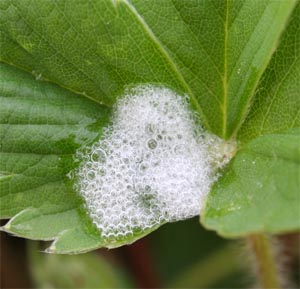
it is mixed with a substance secreted by epidermal glands that enhances surface viscosity and stabilizes the foam to make it last longer. This mixture is forced out of the abdomen under pressure and as it is mixed with air, it forms bubbles. Some species can produce as many as 80 bubbles per minute. The spittlebug moves its abdomen up and down and as the bubbles emerge, it reaches back with its legs and pulls the bubbles forward over its back. The foam serves a number of purposes, protecting the nymph from predators as well as providing insulation from temperature extremes and a low humidity environment so the tender nymph doesn’t desiccate.
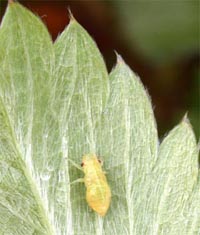
Adult spittlebugs, sometimes called froghoppers, resemble stubby leafhoppers and are generally tan to brown or gray. They’re able to hop great distances but rarely fly (even though they do have wings). Meadow spittlebug nymphs are typically a pale green or yellow, while pine spittlebug nymphs are brown. Spittlebugs overwinter as tiny white eggs in plant stems. The eggs hatch in early to mid-spring. Over the next month or two, the nymph feeds within it spittle, molting two to four times. The nymph finally molts to an adult in late spring or early summer, emerging from its froth. Adults continue to feed through the summer, migrating to new hosts as foliage dries out, but are rarely noticed without the conspicuous spit. In late summer to fall, females lay overwintering eggs. There is only one generation each year.
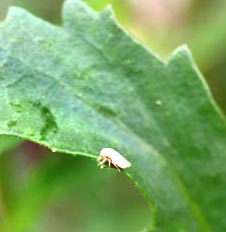
Both the adults and immatures feed on plant sap. Unlike most sucking insects that feed on the phloem, spittlebugs feed on the xylem. The water-carrying xylem is much less nutrient rich than the phloem, so the bugs must process large quantities of sap in order to get the amino acids they require for growth and development. The nymphs survive better on plants with more amino acids in the xylem. Since legumes and other nitrogen-fixing plants have higher amino acid levels than many other plants, spittlebugs are often found on them.
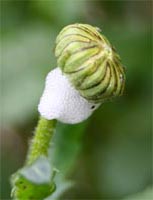
Depending on the species, spittlebugs feed on many types of grasses, weeds, and other herbaceous plants. They are commonly seen on roses, chrysanthemums, Shasta daisies, and goldenrod. Meadow spittlebug feeds on a wide range of plants including alfalfa, clover, strawberries and many garden plants. Pine spittlebug, Aphrophora parallella, is occasionally seen on the foliage of Scotch, Austrian, and white pines, spruces, and firs.
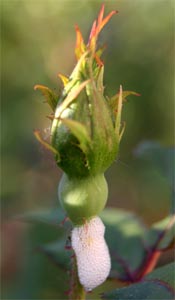
Spittlebugs generally cause little damage to ornamental plants but many people are distressed by the appearance of the spit globs or don’t like getting wet from “bug spit” when picking berries. A strong stream of water will wash the froth away, exposing the nymph to predators or drying out. However, this will not eliminate the insects as they quickly resume frothing once they climb back onto a suitable plant. They can require control on strawberries when numerous (and particularly during dry weather) because their feeding reduces yield and causes stunted fruit. If control on strawberries is necessary, insecticides can be recommended by your local Extension office. The pine spittlebug also requires control if it is numerous because the wounds caused by their feeding result in resinous deposits that can restrict sap flow and allow entry of plant pathogens.
– Susan Mahr, University of Wisconsin – Madison
Latest from Wisconsin Yard & Garden
Ask Your Gardening Question
If you’re unable to find the information you need, please submit your gardening question here:





 Aster, Symphyotrichum spp.
Aster, Symphyotrichum spp. Fascinating Fasciation
Fascinating Fasciation Alternatives to Lawn: Groundcovers
Alternatives to Lawn: Groundcovers Marigolds
Marigolds


